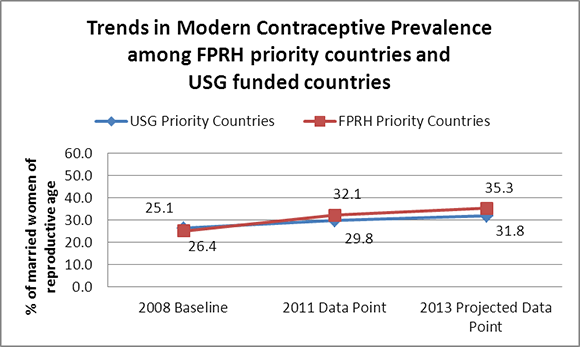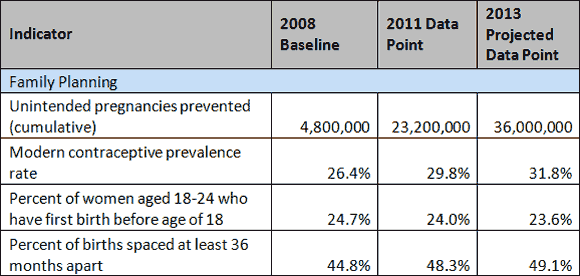Family planning is a life-saving intervention for both women and children. Unintended pregnancies, particularly those that result in births that are spaced too closely together, that result in women having too many children, or that result in women having children too early or too late in life, are dangerous for both the mother and baby. Although global contraceptive use has increased significantly over the last few decades, it is estimated that 215 million women globally would like to space or limit future childbearing but are not using contraceptives. The U.S. Government set an ambitious target to increase modern contraceptive prevalence to 35 percent across U.S. Government-supported countries by the end of the Global Health Initiative (GHI), thereby preventing 54 million unintended pregnancies.
The material presented here is also available in an easily printable format [PDF, 1.8MB].
How is the target measured?
|
-
Unintended pregnancies prevented: Unintended pregnancies prevented measures the cumulative number of unintended pregnancies prevented over the course of the GHI. Unintended pregnancies prevented is calculated using a model that takes into account factors such as contraceptive prevalence, contraceptive method use, and contraceptive method effectiveness, per user cost, and annual U.S. Government funding levels for family planning and reproductive health.
-
Modern contraceptive prevalence (MCPR): MCPR is a direct measure of the desired outcome of family planning and reproductive health programs. MCPR measures the percentage of reproductive age women (15–49 years old) in union who are currently using a modern method of contraception. Data on MCPR is collected routinely through Demographic and Health Surveys (DHS).
-
Percent of women aged 18–24 who have first birth before 18: Early childbearing has multiple detrimental health and non-health consequences. In addition, delaying the initiation of childbearing helps slow population growth by lengthening the time between generations. This indicator measures the proportion of women who had a first birth before age 18 among women aged 18–24 at the time of the survey (typically a DHS), which we hope to see decline over time.
-
Proportion of all births intervals that are 36 months or longer: Longer birth intervals are associated with a significant reduction in risk of mortality for both mothers and infants. This indicator measures the proportion of births with an interval of 36 months or longer in the 5-year period preceding the survey, out of all births in that same period.
Learn more specific information on measurement and data limitations.
What are the U.S. Government-supported countries?
|
Countries receive funding based, in part, on an analysis of need (both the severity of the health problem and the number of people affected by the health problem) and the U.S. Government’s ability to affect health programs.
Donor resources represent about 50 percent of available resources for family planning and reproductive health, with the U.S. Government comprising about half of the donor share. Thus achievements in increasing MCPR are shared by many actors. A strong family planning program can be expected to increase MCPR by approximately 1 percentage point annually, with more successful programs able to maintain a 2 percentage point annual increase over time. The increase in MCPR in U.S. Government priority countries, shown below, is in line with this trend. This global average calculated across 27 countries that received at least $2 million in U.S. Government family planning resources in 2008, have a MCPR < 50 percent and have two data points in time) masks the stronger performance of a set of 13 priority countries that have received sizeable funding increases since 2002. The average rate of change in MCPR for this subset has been 1.7 percentage points annually.
 |
|
Data Source: Demographic and Health Survey, Data reflects calendar year. |
At actual and expected resource levels, we estimate that 4.8 million unintended pregnancies were prevented in 2009, rising to 6.4 million per year in 2011 and remaining constant at that level through 2013, as a function of U.S. Government investments in this area. This results in an estimated cumulative total of 36 million pregnancies prevented by 2013.
Return to GHI Results >>





